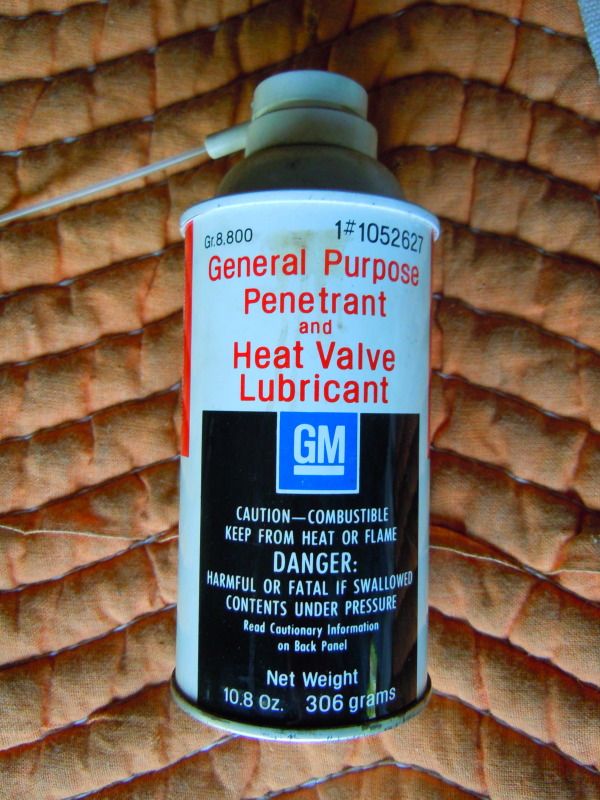Does anyone know a quick fix to silence a chattering brand new heat riser. Just put new exhaust in my 63 coupe and I'm hoping I don't have to disassemble to stop its loud chattering. Thanks, JOe
heat riser chatter
Collapse
X
-
- Top
-
Re: heat riser chatter
The OP seems to be incommunicado.
The anti-rattle spring is easy to lose, and a lot of people don't miss it since they have no clue what it's there for.
Once he finds his missing spring, then he may use the stuff you show there in your very professionally composed photograph. Good thing it says "GM" on the can, otherwise it gets a little dot on the judging sheet.
The better option would be to wire the dam* thing open, but that's only if he drives his car, which I doubt.Last edited by Joe C.; April 25, 2012, 01:05 PM.- Top
Comment
-
Re: heat riser chatter
Joe all topics are interesting about our Corvettes. I have had good results wiring the heat riser open on my 68 and 70. The right side mufflers have not rusted out, the 68's right side muffler was replaced twice before the wiring the hear riser open. The 68's right side muffler has been on now for over 25 years, the 70's right side muffler has been on for about 23-24 years.Both right side mufflers have no rust out like prior mufflers. Went an extra step about three years ago in plugging the crossover in the intake manifold of the 68 so no exhaust could flow up into the intake.- Top
Comment
-
Re: heat riser chatter
Joe,
If your 63 is a low hp car like mine I suggest not wiring the valve open because the cast iron intake manifold needs that heat to properly vaporize the fuel. If you have an aluminum manifold I agree with other posters to wire the valve open.- Top
Comment
-
Re: heat riser chatter
Joe,
When you say the heat riser is brand new, do you mean a current reproduction part, or the currently applicable GM service part (if not discontinued), or do you mean a NOS GM 3746838 heat riser valve, the original part number shown on Section 6, Sheet B-1 of the '63 AIM?- Top
Comment
-
Re: heat riser chatter
If you intend to lubricate the thing, then get yourself some anti seize, dilute it with some penetrating oil and get it between the shaft and bushings (or cast iron housing in the case of a repop valve). The spray lube is a dedicated item and, expensive. The anti seize compound will persist longer and has multiple uses.
Timothy: I'm not sure that I agree with your assessment of the intake manifolds. Cast iron does take longer to heat up, but once at op temp, aluminum sheds heat faster than cast iron and thus has a tendency to stay cooler, thus demonstrating why cast iron will vaporize the fuel faster and better than aluminum, not vice-versa. Since most of us don't drive these things in ambient temps much lower than (around) 45 or so degrees, F, then the entire issue becomes moot. I wholeheartedly agree with Jim Trekell about sealing the exhaust crossover shut. I have had my 327 that way for years, now and it starts and runs beautifully, making more power that it would have with a hot intake manifold. Furthermore, this engine runs a race carburetor with no choke and no choke horn. It starts immediately in 45 degree weather with 6-7 pumps of the throttle. I have to goose the throttle for the first 30 seconds to keep it from stalling, but beyond that it idles on it's own. This is without any choke mechanism at all.
So, a properly tuned engine with no choke, no heat riser, and no exhaust crossover in the aluminum intake will start, run, and drive beautifully in temps as low as (around) 45 degrees, F.- Top
Comment
-
Re: heat riser chatter
To add to the concerns on whether to use or "wire open" the heat riser control valve; I'm a firm believer in "trying" to keep the equipment and function thereof as stock as possible deferring to the original Engineer's design and intent. However, the game (available fuel and emission rules) has changed and we all have had to adapt to it. The simple thing to do for driveability when operating on summer blends is to wire open the heat riser butterfly. I have done this for many years in the summer, but preferred to return it to normal operation during the cooler months (we say cooler here in Florida, you might say winter up north). My car's exhaust will usually tell me when it's time to change when it starts spitting water out of the RH tail pipe. I noticed this just yesterday. This year; however, I'm finally going to remove the butterfly valve and replace it with a FI spacer block which I ground out the inside full round. Our cool season was so mild and the days I drove the car so warm that it convienced me I no longer need it.
Stu Fox- Top
Comment

Comment